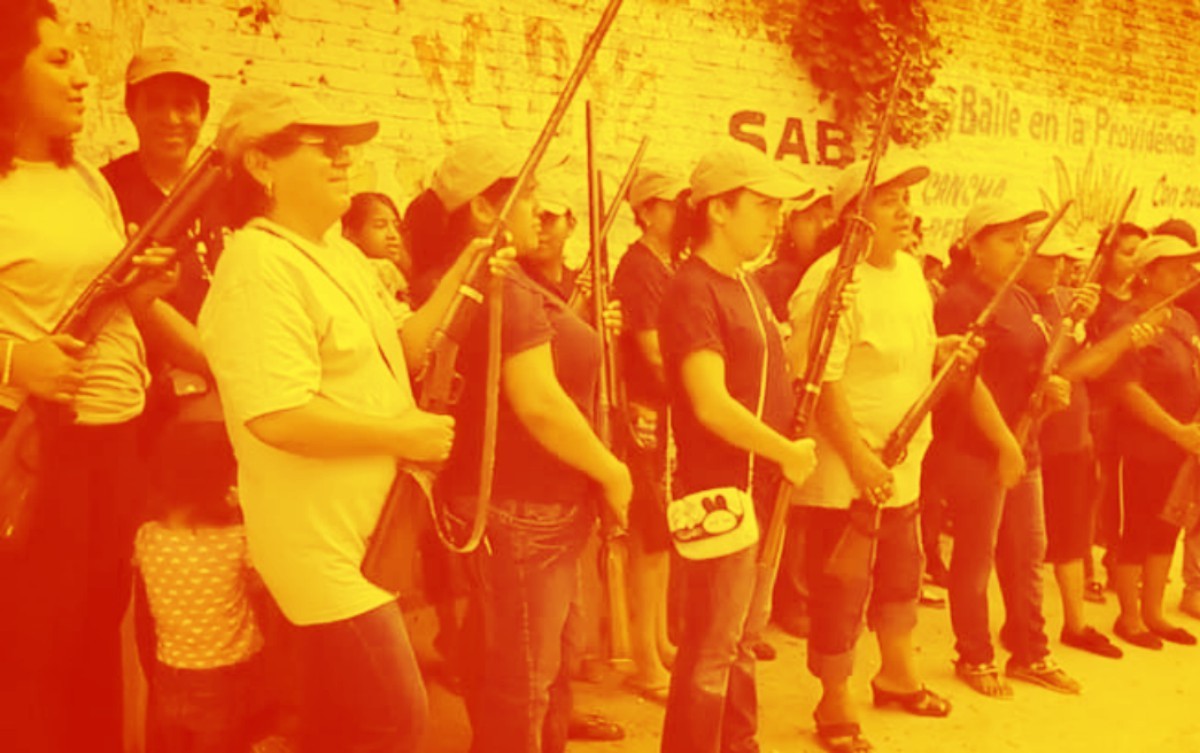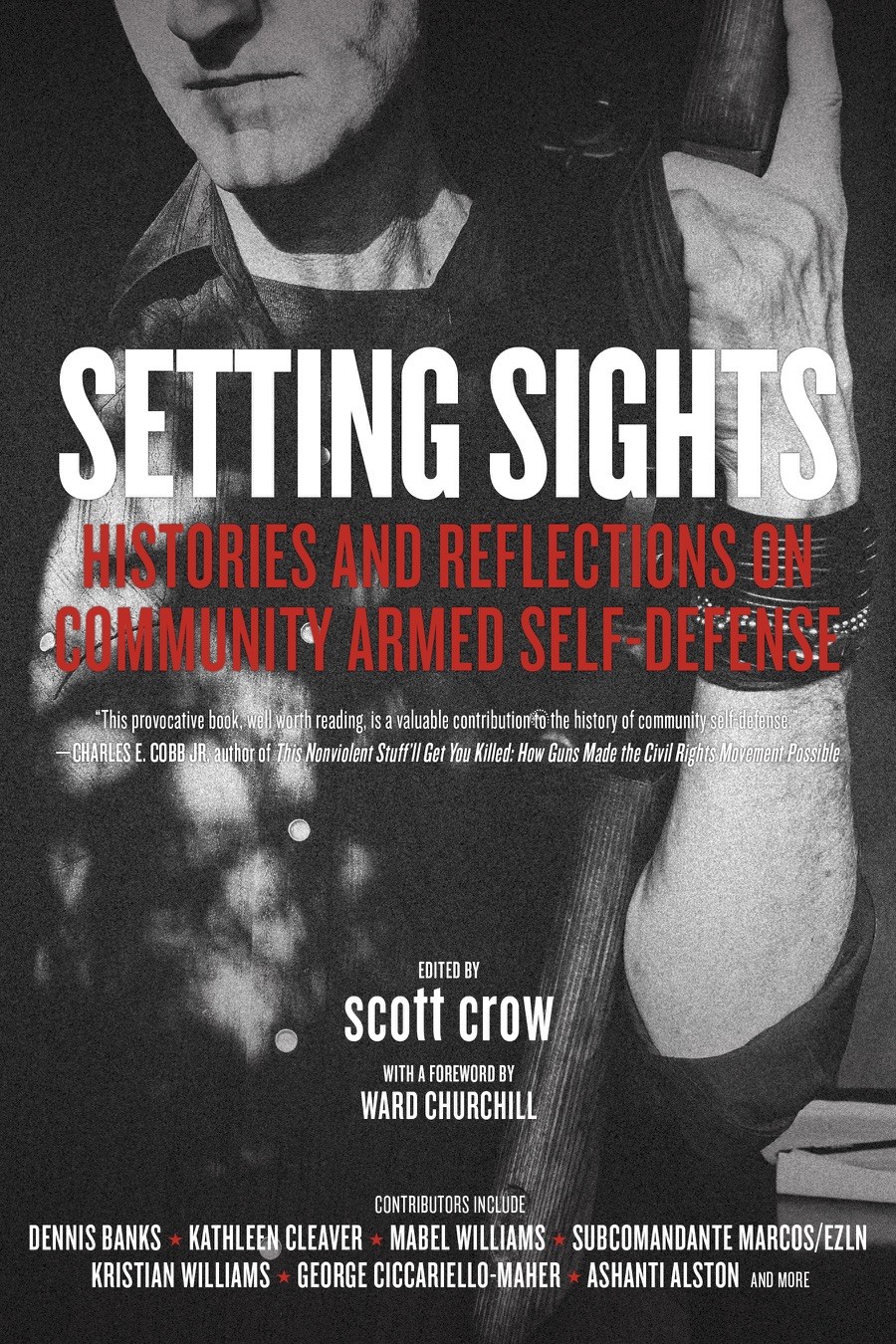Filed under: Analysis, Anarchist Movement, Community Organizing, Featured, Video

Editor’s Note: This essay is an excerpt from scott crow’s new book Setting Sights: Histories and Reflections on Community Armed Self Defense, out soon from PM Press. In it he describes the basic concepts and praxis of the book. Be on the watch soon for a chance to snag a discounted copy of scott’s new book through IGD at a discounted rate and check out our recent podcast with him here.
Liberatory Community Armed Self-Defense: Approaches Toward a Theory
The world has been in tumult for decades, with more crises still ahead of us—from ecological and economic to political oppression and wars. These slow disasters will demand new approaches and open new possibilities. I think it’s time for all of us within civil society to think about how we want to respond, autonomously and collectively, without waiting to be saved by the same reactionary governments and corporations that have produced the crises in the first place.
In this essay, I will try to sketch a set of potential practices, praxis, and thinking centered on the narrow use of what I name as liberatory community armed self-defense. This distinct concept draws upon the histories of community self-defense, as practiced by various groups of people worldwide, and from the liberatory principles derived from anarchist and antiauthoritarian traditions.
The concept of community armed self-defense is a distinct development from grassroots social and political organizing models and notions of community defense, which at their core assert the right of oppressed peoples to protect their interests “by any means necessary.” That would include signing petitions and voting on one end of the spectrum to extralegal means of direct action, insurrection, or rebellions on the other. The Black Panther Party, for example engaged in community defense not only through their armed patrols but also through their survival programs, which opened health clinics and free schools in poor black neighborhoods otherwise lacking these kinds of services. This essay is an attempt at a critical reassessment of liberatory community armed self-defense: to re-envision the histories and analysis, to examine the praxis and bring these lessons forward to future engagements, and to broaden and strengthen our tactics and responses to crisis.
A Working Definition
Liberatory community armed self-defense is the collective group practice of temporarily taking up arms for defensive purposes, as part of larger engagements of collective autonomy in keeping with a liberatory ethics.
I am proposing liberatory community armed self-defense as a distinct idea borne out of a reassessment, spanning decades, of the historical experience of armed struggle and broader theories of the right of self-defense.
Self-Defense usually describes countermeasures employed by an individual to protect their immediate personal safety, and sometimes their property. Within the US, self-defense is discussed almost exclusively in legal terms relating to “rights” recognized by governments or constitutions, and only occasionally as human rights. By limiting the discussion to the rights attached to individuals, this framing fails to consider community interests, structural violence and oppression, and collective actions. The discourse thus completely neglects the defense of communities as such, and especially leaves out the political demands of people of color, women, immigrants, queers, and poor people.
Community self-defense in any form is not defined by laws but by ethics based in need (to protect) and the principles of anarchy (whether people call it that or not) by which groups of people collectively exercise their power in deciding their futures and determining how to respond to threats without relying on governments.
As a concept, Liberatory Community Armed Self-Defense attempts to take into account unrecognized types of violence and the limits marginalized groups face in their ability to determine their own futures or collectively protect themselves. For example, in 1973, when the American Indian Movement took up arms to defend “their people” in the occupation at Wounded Knee, they did so to bring attention to the horrible living conditions on the reservations and the violence their communities faced both from a lack of basic services and from armed vigilante squads. The town of Wounded Knee was not itself under attack, but it represented what First Nations were facing everywhere. AIM’s stand was a clear example of community armed self-defense, but it doesn’t fit neatly into existing typologies of self-defense.
Some Important Distinctions
Liberatory community armed self-defense is different from other forms of armed action for two major reasons. The first is that it is temporary but organized. People can train in firearms tactics and safety individually or together but would be called on more like a volunteer fire department—only when needed and in response to specific circumstances. Second, and possibly more importantly, power-sharing and egalitarian principles are incorporated into the group ethics and culture long before conflict is ever engaged. These two overarching ideas separate it from most armed conflicts.
For instance, right-wing militias—like the anti-immigrant patrols of the Minutemen Militia along the U.S./Mexico border, or the racist Algiers Point Militia operating in the aftermath of Hurricane Katrina—have nothing to do with the type of community armed self-defense rooted in collective liberatory principles. These militias are built on abstract fears and racist beliefs, conspiracy theories, and a macho culture where the strongest or loudest is the leader. They are typically organized in military-type hierarchies with no real accountability to the people in civil society and the communities they operate within. These types of militias are far too similar to the types of the groups liberation movements have had to defend themselves against.
That said, the adoption of armed tactics in any conflict or threat situation always has the potential to morph temporary defensive measures into permanent military hierarchies unless conscious efforts to counter that tendency and share power are maintained. A liberatory approach is necessary to minimize, or at the least mitigate, that danger.
Proposed Principles
The armed component should never become the center; otherwise we risk becoming standing militaries. To avoid that, and to equalize power as best we are able to, a liberatory analysis is necessary to nurture those who are learning to exercise their power, and for those who need to be accountable to their groups or communities. The liberatory framework is built on anarchist principles of mutual aid (cooperation), direct action (taking action without waiting on the approval of the authorities), solidarity (recognizing that the well-being of disparate groups is tied together) and collective autonomy (community self-determination).
Defensive arms should be used only for the goals of collective liberation and not to seize permanent power, even if their use could potentially, and possibly necessarily, escalate conflicts. In any case, arms are not the first line of defense and are only taken up after other forms of conflict resolution have been exhausted.
The use of arms is only effective for the long term if it is part of a dual power framework. Dual Power means resisting exploitation and oppression, while also developing other initiatives toward autonomy and liberation as part of other efforts in self-sufficiency and self-determination.
Those engaged with guns should hold the same power as others involved in other forms of community defense or self-sufficiency. Carrying arms should be seen as a privileged task, with the same importance as childcare, growing food, or taking out the garbage—and not more. To maintain a balance of power, rotate all armed tasks and training among all those willing to participate. All firearms training needs to include dynamic and evolving liberatory ethics and practices in addition to how-to and safety. Within any training or operation, there should be an emphasis on challenging internalized assumptions about class, gender, and race to interrupt typical gun culture.
Reflections and Questions Toward a Theory
These notes are only a beginning. Many questions remain, including those concerning organization, tactical considerations, the coercive power inherent in firearms, accountability to the community being defended and to the broader social movement, and ultimately, one hopes, the process of demilitarization. For example: Do defensive engagements have to remain geographically isolated? Are small affinity groups the best formations for power-sharing and broad mobilization? How do we create cultures of support for those who engage in defensive armed conflict, especially with respect to historically oppressed people’s right to defend themselves? What do those engagements of support look like? Additionally there are many tactical considerations and questions to be discussed and debated to avoid replicating the dominant gun culture. How do we keep arms or arms training from becoming the central focus, whether from habit, culture, or romanticization
There can be an end to the senseless violence for domination or resources. But if we want to transcend violence in the long term, we may need use it in the short term. We thus need to ask ourselves some tough questions about our approaches and our methods. When is armed engagement appropriate? How would we want it to look? How do we create cultures of tacit or direct support and include people who would never themselves engage in armed defense? How will we keep from centralizing power? When do the consequences outweigh the benefits? There are no blueprints; we have to create this together, step by step. We need to challenge ourselves and overcome our self-imposed limitations and shed our preconceptions of what resistance and liberation are like. When we do, we will gain confidence in potentially using deadly tools with a liberatory consciousness. That means we have to understanding that the values of power-sharing and openness are every bit as important as the power of carrying loaded weapons.
Arms will never offer the only answer to exercising or equalizing power. Only we can do that, but they can be a deterrent against real threats, and can greatly expand our tools of liberation. Community armed self-defense opens up the possibility of changing the rules of engagement. It doesn’t always make situations less violent, but it can help to balance the inequity of power among individuals and diverse communities. I am not calling for us all to rise up in arms but to rethink how we defend ourselves. We can dream, we can build new worlds, but to do so we must not forget to resist on our own terms.







